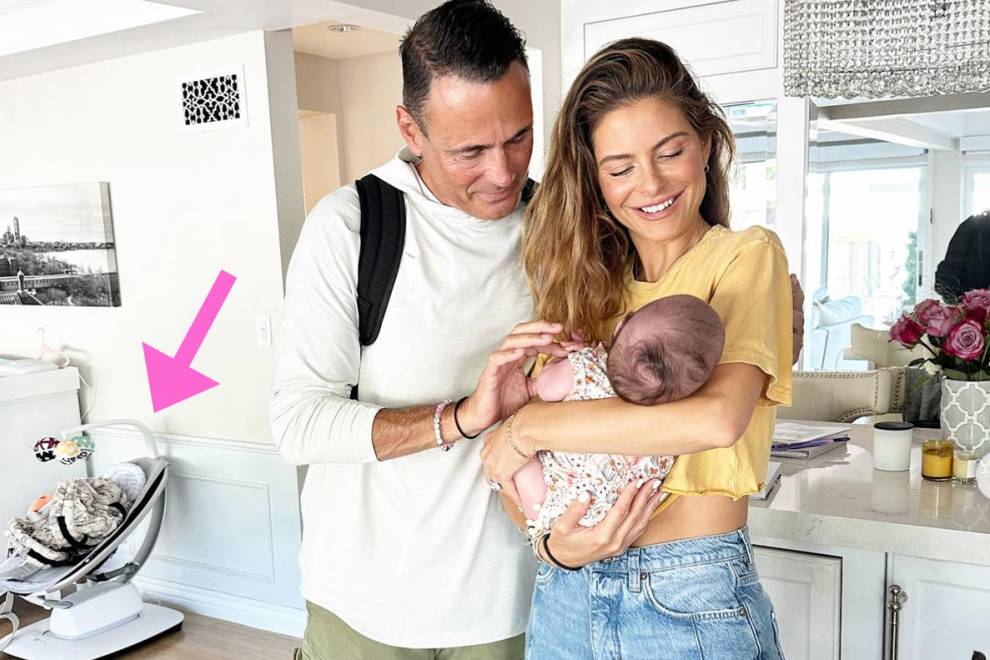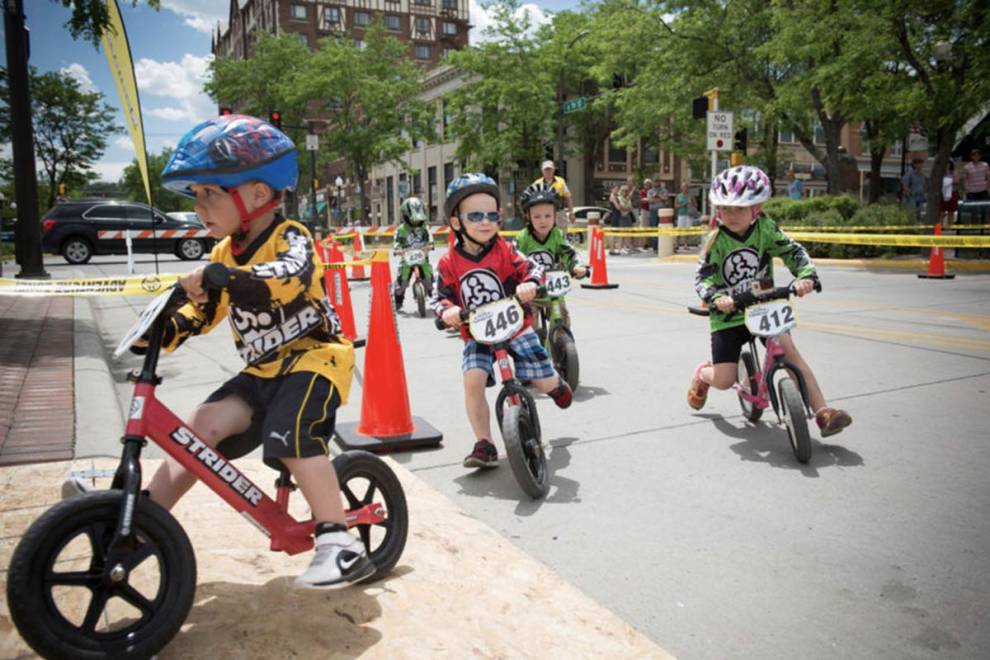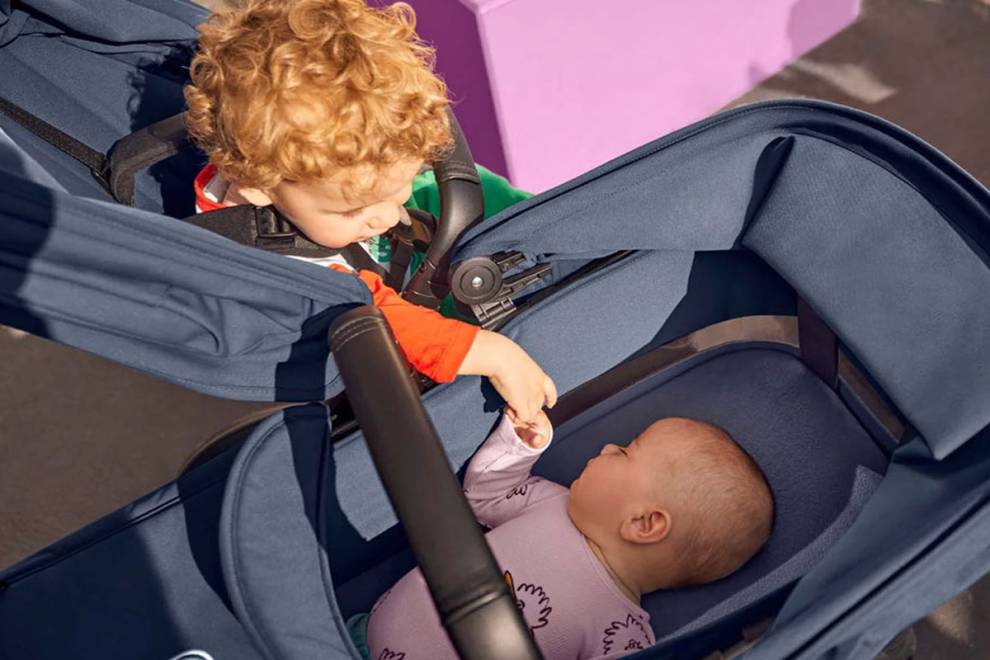Rock-a-bye-baby! Our guide helps you find the perfect bassinet for your little one.

Mommyhood101 independently tests and curates baby gear to help you make informed decisions. If you buy products through links on our site, we may earn a commission.
Wondering how we arrive at our annual list of the best bassinets? This buying guide will walk you through the process!
There is a lot of prep work for expectant parents to complete in the short nine months before the baby arrives. One of the biggest jobs is creating a safe space for the baby to sleep.
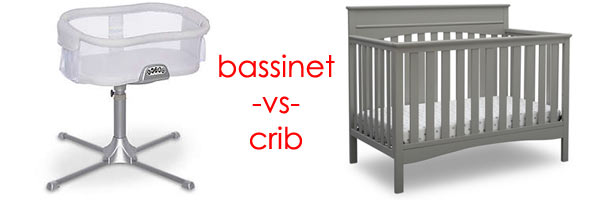
While there is often a great deal of focus on the nursery, new parents must also consider a closer sleeping space for the baby’s first months. The American Academy of Pediatrics guidelines encourage parents to "keep baby's sleep area in the same room where you sleep for the first 6 months or, ideally, for the first year."
Place your baby's crib, bassinet, portable crib, or play yard in your bedroom, close to your bed. The AAP recommends room sharing because it can decrease the risk of SIDS by as much as 50% and is much safer than bed sharing. In addition, room sharing will make it easier for you to feed, comfort, and watch your baby.
Bassinets are crib alternatives that may appeal to parents for a number of reasons, including space, design, and lifestyle choices. Here are some comparisons and tips for selecting the best bassinet sleep space for a new baby.
Bassinet vs. Crib: Advantages of Buying a Bassinet
Furniture Footprint: A bassinet will take up considerably less space than a full-size crib or even a portable crib. Bassinets are often compact and will fit more easily in the parent’s bedroom.
Co-sleeping is easier: Because of their small footprint, bassinets facilitate co-sleeping for new parents. Many bassinet options will fit snugly beside a parent’s bed, and some models will swivel in closer to make nighttime feedings even easier.
Easier to lay baby into a bassinet: Bassinets tend to be shallower than cribs and play yards, so parents will often have an easier time leaning in to put the baby to bed. This is especially important for mothers who have had a C-section, as some leaning and bending may be uncomfortable or prohibited until the surgical stitching heals.
Bassinets are more portable: Unlike play yards, which may require collapsing and re-assembly when moved, many bassinets are easily moved from one room to another. Often bassinets are compact enough to be simply carried to another room. Additionally, some bassinet models have a lift-away option allowing parents to remove just the sleeping space from its stand.
Shades for naptime: Hoods and shades are common features for many bassinet models and offer a low-light space to help babies nap.
Cozy: Babies are typically comforted by closeness and feeling snug as it reminds them of the womb. This is why swaddling can help calm infants. Thus, some babies may sleep better in a bassinet’s narrower sleeping area.
Gentle Motion: The option for motion can be a game changer for parents deciding between a crib and a bassinet. Motion options for bassinets include cradles, rockers, and mechanical movements.
Bassinet vs. Crib: Disadvantages of buying a bassinet
Babies grow quickly: When compared to cribs, bassinets will include much lower weight restrictions along with other safety guidelines. Babies grow very quickly in their early months, and many parents may find their baby soon exceeding the weight limits, usually around age six months.
Less stretching space: While most babies prefer a tight swaddle and the comfort of a snug space, there are some babies who prefer to stretch out. These babies may not appreciate the coziness of a bassinet. Additionally, these babies may wake easily when trying to stretch and bumping their arms or legs on the bassinet walls.
More cost, more transitions: Any extra piece of baby gear or nursery furniture adds cost and hassle, and many parents think bassinets are a great example of that. Bassinets also require an extra transition for your baby (from bassinet to crib) that might cause sleep regressions.
There are definitely some great bassinet alternatives for those who think these are serious detractors!
Types of Bassinets
Bassinets and other compact crib alternatives are available in a variety of styles, each with its own advantages and drawbacks. Here are the most prevalent models.
Classic Stationary Style
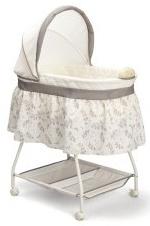
- Pros: These units are sturdy with a strong frame. Many stationary bassinets include a storage feature under the basket, increasing the space-saving opportunity. Some stationary models include wheels to facilitate easy moving.
- Cons: As stationary bassinets are designed with a strong footprint, some models may be wider than other bassinet styles, making them more difficult to fit beside the parents’ bed (depending on room space and layout). Parent reviews on some stationary models demonstrate concern for the thinness of included mattress pads. However, in a SIDS prevention article, the Mayo Clinic reminds parents to, “Use a firm mattress and avoid placing your baby on thick, fluffy padding, such as lambskin or a thick quilt. Don't leave pillows, fluffy toys, or stuffed animals in the crib. These can interfere with breathing if your baby's face presses against them.” Concerns for the baby’s comfort on included mattresses can be discussed with the family’s pediatrician for medical safety advice.
Rocking Cradles
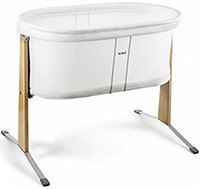
- Pros: Cradles and rocking bassinets offer a lulling motion to soothe babies to sleep. Many rocking models also include a gentle vibration feature for added relaxation, and some even include a suspension system to rock naturally in response to the baby’s movements. Certain rocking sleepers include a built-in incline which can be particularly helpful for colicky babies and babies with acid reflux.
- Cons: As with all crib alternatives, cradle bassinets will be outgrown and require a crib when the baby meets the size/ weight limitations. However, more than other bassinet styles, parents may notice a greater struggle when transitioning from cradle to crib, as the baby may become accustomed to the soothing movements. Models with music, vibration, and automatic rocking features will require frequent battery replacements. For this reason, parents interested in this type of cradle should sincerely consider a quality set of rechargeable batteries. Due to the space needed for rocking, most cradle styles will need to be placed farther from the parent’s bed, which means parents will need to get out of bed to access the baby for nighttime soothing and feeding.
Co-Sleepers
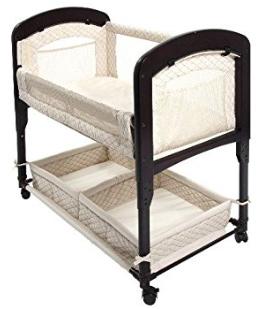
- Pros: Due to "the possibility of suffocation, strangulation, and entrapment" the American Academy of Pediatrics recommends, that "infants sleep in the parents’ room, close to the parents’ bed, but on a separate surface designed for infants." For this reason, co-sleepers are a great option to get closeness in a safe manner. Co-sleepers are designed to be positioned directly at the bedside with adjustable height features for the perfect fit; see our Newton bassinet review for a great example of a bedside bassinet. Some co-sleeper models even include a movable sidewall for instant access to the baby without getting up at all. This can be particularly important for breastfeeding moms who are still resting and healing from a C-section. According to the Mayo Clinic, “[Moms] can begin breast-feeding almost immediately after the C-section. One breastfeeding position that works well during C-section recovery includes side-lie holding. Lie on your side and place your baby on his or her side, facing your breast. Support your baby with one hand. Once your baby latches on, use one arm to support your own head and the other to help support the baby.” The co-sleeper option would facilitate this practice, supporting both healing and breastfeeding.
- Cons: Some co-sleepers overlap the bedside*, reducing sleeping space for the parent(s). While some parents may find sleeping so near the baby, others may find it negatively impacts sleep quality as they try not to move or make too much noise for fear of waking the child. Additionally, concerns for self-soothing development arise when babies are eventually transitioned into a crib after being so close to their parents for the first 6 months - 1 year.
*An important note regarding the difference between bedside sleepers and in-bed sleepers as observed in the Journal Pediatrics by the AAP: “Bedside sleepers are attached to the side of the parental bed. The CPSC has published safety standards for these products, and they may be considered by some parents as an option. However, there are no CPSC safety standards for in-bed sleepers. The task force cannot make a recommendation for or against the use of either bedside sleepers or in-bed sleepers, because there have been no studies examining the association between these products and SIDS or unintentional injury and death, including suffocation.”
Travel Bassinets

- Pros: For traveling families, or for houses/ bedrooms with limited extra space, a fold-away sleeper offers functionality while the baby sleeps, and easily collapses for closet or under-bed storage when not in use. Travel sleepers are often lightweight, and some even include removable fabrics for machine washing.
- Cons: Travel bassinets tend to have a wide footprint when in use. This may be to support structural integrity for the light frames, but it can be nonetheless problematic for some spaces. Additionally, some travel sleepers lack deep pockets or storage baskets; certain models include no storage at all.
Moses Baskets
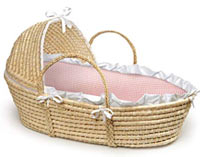
- Pros: There is no denying the photogenic qualities of these baskets. Found in a variety of materials from traditional wicker to modern mesh. Moses baskets (or badger baskets) are some of the smallest bedding options available. They are also some of the least expensive (depending on the brand). Basket sleepers are lightweight and incredibly portable, often including handles, such as on the popular Badger Basket (pictured to the right). Most baskets can be placed on the floor for use, and stationary and rocking stands are available for some models.
- Cons: Mattresses for basket sleepers are not standardized, so finding replacements has been troublesome in the past. However, with newer basket options on the market, individual brands have begun offering replacement mattresses and pads for their models. There is some concern for safety with regard to semi-rigid basket models and carrying children in them, and these baskets were only added to U.S. Consumer Product Safety Commission safety regulations in 2013. The modified standards now include, “bassinet/ cradle products that do not have legs and sit directly on the floor” with consideration for restraints and transportation. Because there is potential for some soft wicker frames to be pushed away from the mattress edge, parents may want to consider breathable mesh options for overnight use.
Choosing the Best Bassinet for Your Budget
Depending on style and model, bassinets can range in price from $50 to around $200, with some elite brands extending upwards over a thousand dollars (like the popular SNOO). Simple stationary models and travel option sleepers tend toward the lower price range. Rockers trend a bit pricier, as do quality Moses/badger baskets (especially when considering the optional basket stands. On average, bedside co-sleepers are the priciest styles on the market. Bassinets with high-end features like motion, music, and suspension will also carry higher price tags.
Pro Tip: If you're unsure whether to invest in a bassinet, start with a safe, portable model. You can always transition to a crib once your baby outgrows it around six months.
Bassinet Safety
General Guidelines for Safe Sleeping
The American Academy of Pediatrics outlines safety measures to ensure a safe, comfortable sleeping environment for babies. Major points include:
- New babies should room-share, but not bed-share, for at least six months to a year. "If you do fall asleep, as soon as you wake up be sure to move the baby to his or her own bed.”
- Bassinets (as well as cribs) should include a firm sleep surface and a tight-fitting sheet. Babies should always be placed on their backs to sleep.
- Baby’s sleeping space should be bare. Soft bedding, bumpers, pillows, blankets, and soft toys can create a suffocation hazard.
Additionally, the Consumer Product Safety Commission advises that parents shopping for a bassinet should look for models that meet the following criteria:
- The bassinet should include a sturdy bottom with a wide base.
- All bassinet surfaces should be smooth.
- There should be no hardware sticking out on the bassinet.
- Bassinet mattresses must be firm and must fit tightly within the unit.
Wheel Locks
Bassinets that include wheels should also include strong, sturdy wheel locks. Parents should test these locks for security on all surfaces where the product will be in use.
Floor Surfaces and Center of Gravity
When setting up the bassinet, parents should check the unit’s center of gravity to ensure proper stability. Some lightweight bassinets may be easily bumped around or knocked over depending on the floor surface. Testing the unit’s stability will help ensure careful use.
Transporting Bassinets
Unless specifically designed for this purpose, parents should not move the unit with the child inside. Even if the bassinet includes handles, the baby still may shift and slip on the mattress, creating a strangulation and suffocation hazard. Parents should be sure to carefully read bassinet use instructions and safety guides, and stay aware of safety regulations.
Mattresses and Sheets
Parents should use only the mattress or pad provided by the manufacturer. If the mattress needs replacement, parents should search for an exact replica from the manufacturer or one that is specifically approved for their bassinet model. There should be no gaps between the mattress and the sides of the bassinet. Sheets should be fitted to the exact mattress size, and parents should never use a pillowcase or other un-fitted sheet to cover a bassinet mattress.
Pro tip: Spit-ups and diaper blow-outs are common, especially for newborns and infants. There may be nights when you will need to change the baby’s sheet more than once. For this reason, parents should invest in at least three, fitted sheets for the bassinet: one for the wash, one for replacement, and one for backup.
Developmental Milestones
In addition to safety guidelines for use and weight restrictions indicated on each product, parents will want to watch for developmental milestones indicating their child is ready to transition to a crib. When babies begin rolling over or pushing up on their hands and knees, they are at risk of tipping over and/or falling out of the bassinet. For safety, parents should immediately transition to a crib at this point.
Bassinet Accessories
Bassinet Stand
Stationary and rocking stands are available for many bassinet models, especially basket-style beds. When selecting a stand, parents should ensure the selected stand is approved by the manufacturer for use with the specific bassinet model. There are a variety of stand shapes available including ‘X’ frame collapsible stands, four-leg stands, and rocking stands. Depending on hinge quality, some X-frame stands may not be as sturdy as four-leg and rocking stands. However, four-leg and rocking stands are likely to take up more space than X-frame options.
Storage Caddies/ Organizers
Some bassinet models allow for attaching storage caddies and/ or diaper organizers. These optional features are often designed to clip and hang from the side of the bed. Smaller caddy options are simple, one or two pocket pouches to hold small, nighttime essentials. Medium-sized storage caddies include more pockets and space, and the largest hanging organizers have reinforced shelving and multiple pockets for holding various items including lotions, bottles, toys, and large quantities of diapers. To prevent the risks of pinching and bassinet tipping, parents should ensure selected caddies are approved for their sleeper and avoid overfilling the storage unit. Any clip-on or hanging caddy should be positioned out of the child’s reach and should be removed from the sleeping area when the baby begins to push up on hands and knees.
Rainbows and Mobiles
Rainbow toy hangers and clip-on mobiles are available for many bassinet styles (some bassinets even come with these options included). Some battery-powered mobile options include lights and sounds. When selecting a mobile, parents should ensure their bassinet model is intended for attachments and can properly position and support the weight of the mobile. Additional specifications from KidsHealth indicate strings and ribbons on hanging mobiles and toys should not exceed 7 inches (18 centimeters) in length. Once the baby is able to push up on hands and knees or reaches five months of age (whichever comes first) all hanging mobiles and toys should be removed from the sleeping area.
Incline Inserts and Wedges
Some bassinets come with “incline” inserts or wedges, designed to elevate the baby’s head and torso. Inclined sleeping surfaces should never be used. Parents should note that the AAP advises against using inclined sleep products for unattended sleep, as they have been associated with suffocation risks. The U. S. Consumer Product Safety Commission issued a warning regarding these products as they are extremely dangerous. The CPSC and AAP, therefore, urges consumers to stop using these products.
Frequently Asked Questions (FAQ)
How long can a baby sleep in a bassinet?
Most babies outgrow their bassinet between 4 and 6 months of age, or when they reach the manufacturer’s weight limit, roll over, or push up on hands and knees.
Is a bassinet safer than co-sleeping?
Yes. The AAP recommends room sharing without bed sharing for at least six months. A bassinet provides proximity while maintaining a separate, firm sleep surface.
Can I use a secondhand bassinet?
Only if it meets current safety standards, includes the original parts and mattress, and shows no signs of damage or instability. Check for recalls before use.
Are motion or smart bassinets worth the cost?
High-tech bassinets with motion or white noise can help soothe fussy babies, but they’re not essential for safe sleep. Always use safety restraints and flat, firm surfaces.
How many sheets should I have for a bassinet?
It’s best to have at least three fitted sheets: one in use, one in the wash, and one ready as backup for nighttime messes.







